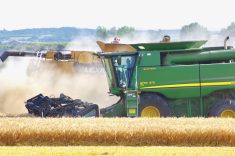WASHINGTON, Nov 9 (Reuters) – The U.S. Department of Agriculture’s 2.1 percent bump to its corn yield forecast on Thursday signals this year’s bumper harvest may get even bigger, as the government has in the past followed up late season increases with further upward adjustments.
The USDA added 3.6 bushels per acre to its already massive harvest outlook in its crop production report on Thursday. That was the third biggest jump of the past 30 years in absolute terms from the October to the November reports — a critical period as much of the crop is harvested during that span and results included in the government’s data.
Read Also

U.S. livestock: Cattle fall sharply as Trump says he’s working to lower beef costs
Chicago cattle futures fell sharply on Friday after U.S. President Donald Trump said his administration was working to lower the…
The government has raised its November corn yield estimate by more than two percent only four times in the past 30 years. In those four years, the final yield figure has come in above the November estimate every time, averaging a 1.3 percent increase.
A comparable increase to this year’s USDA November estimate would add 2.2 bushels per acre to final yields. The government pegged this year’s yields at a record 175.4 bushels per acre on Thursday.
“History says that big crops get bigger,” said Don Roose, analyst at U.S. Commodities.
But this year’s November outlook may be skewed higher as the weather across key growing areas of the Corn Belt favoured corn that was planted early.
“A lot of the corn that remains out there in the field is probably not the best corn that’s going to be harvested,” said Terry Linn of Linn & Associates. “You’re already at a record yield. They could maybe take it up, but I don’t think that’s a slam dunk by any means.”
Additionally, rain and muddy conditions in fields have pushed the pace of harvest well behind its typical schedule, leaving more corn in the fields than is usual when the USDA conducts surveys for its November report. That large amount of late harvested corn may weigh on the final yield total.
Any further bumps to the record yield outlook are unlikely to add much pressure to the corn market, which has faced bearish headwinds from ample global stocks for months.
And USDA is already raising its demand outlook for U.S. corn on both the export front and the feed sector, providing some underlying support to prices.
“Even though we’re seeing the big production number on corn, we’re seeing the demand to go with it, which is big,” said Karl Setzer, analyst with MaxYield Cooperative. “Low prices are expected to cure demand and that’s keeping our market supported for now.”














